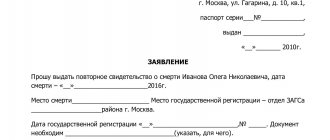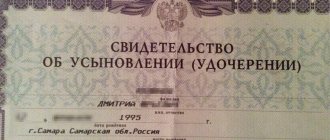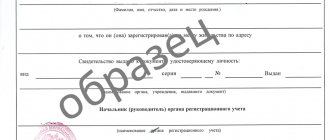State registration of paternity establishment
Based on the legislation of the Russian Federation, in order to establish paternity, you will need to submit an application together with the mother and father of the baby, who were not married at the time he was born.
In addition to this application, you will need an application from the father for adoption , who was also not married to his mother at this time.
The last document that is needed to establish paternity is a court order, which has already entered into force at the time paternity is established.
Actions in case of loss
In case of loss, the certificate of paternity can be restored with a similar application to the appropriate authority. To do this, you must re-pay the state fee in the amount of 350 rubles. and submit an application to the local registry office. A duplicate certificate is issued on the same day.
After documentary confirmation of paternity, the child’s father is issued a certificate establishing such a relationship with the minor. This procedure is carried out voluntarily (in the registry office) or compulsorily (in court). All court costs are paid by the defendant after the court has satisfied the claim to establish paternity.
If you find an error, please select a piece of text and press Ctrl+Enter.
How to get a certificate
A certificate of recognition of paternity is purchased through the civil registry office. You can get it in several ways:
- Both parents submit the application together. If they are husband and wife, then registering the child at birth will not create any problems. To confirm the relationship between the child and the mother, a special document from the maternity hospital will be required, and information about the father will be transferred from the marriage certificate;
- Only the father applies to the registry office. He can independently submit an application in the case when he is legally married to his mother. But there are several more cases when the father can file an application on his own - this is the death of the mother, determination of her incapacity or deprivation of maternal rights; the mother is considered missing and with the consent of the guardianship authorities;
- Acquiring paternity after the child reaches adulthood. Paternity of a child over 18 years of age can be recognized only with his consent;
- Acquiring paternity without legal marriage. If the father and mother are in a civil marriage, then this application is submitted by the mother of the baby. In certain cases, a certificate is provided even before the baby is born, in which case a certificate confirming pregnancy will be required.
Important. By submitting this application, parents automatically agree that the child will be given the surname of the mother or father.
The certificate of determination of paternity is printed on the official form of the civil registry office, certified by signature and seal. It records the following information:
- Names of the child's parents;
- Name, gender, age and birthplace of the child;
- Stamp on the date and time of paternity establishment;
- Information about the organization that confirmed this information;
- A record of assigning a new name to the baby, taking into account recognition of paternity, if any.
When an application is rejected
An application for a certificate of paternity will be accepted only if there is no information about the child’s father in the registry office. If such data exists, then a court decision will be required on the basis of which it could be canceled (for example, a man who was listed as the father challenged this fact in court). But if the information was entered only from the words of the mother and was not supported by documents in any way, a statement from the parents will be sufficient.
Expert commentary
Gorchakov Vladimir
Lawyer
It is also impossible to cancel paternity if the child was born by a surrogate mother or as a result of artificial insemination, and the man gave written consent to this procedure.
Required documents
Depending on various factors, the complete package of documents may vary.
When submitting an application jointly by both parents you will need:
- document from the hospital;
- child's birth certificate (if available);
- marriage registration certificate;
- passport of father and mother;
- receipt of paid state duty.
When presented by the father:
- child's birth certificate;
- marriage certificate (if you have one);
- one of the documents that certifies the death of the mother, the deprivation of her parental rights, the declaration of her incompetent or missing;
- written confirmation of the guardianship authorities for recognition of paternity;
- court statement;
- passport;
- receipt of paid state duty.
If paternity is carried out over an adult child, then the package of documents comes from the applicant. It is therefore the responsibility of applicants to decide whether they will apply jointly or separately as one parent.
Before submitting the necessary documents, you must pay a state fee - 350 rubles .
Next, you will need to collect the necessary documents. In addition, the child’s written consent is required. This can be presented as a single or joint application.
With the consent of the applicants, it is necessary to collect the necessary documents:
- document from the hospital;
- child's birth certificate (if available);
- passport;
- receipt of paid state duty.
The application form is confirmed by the Government of the Russian Federation. You can view it using these links: in doc format, in pdf format.
Cancellation of paternity certificate
The basis for cancellation of a document is a court decision. An application can be made by:
- a man who is indicated in documents as the father of the child;
- the child's mother or other legal representatives;
- the biological father of the child, if paternity is registered in the name of another man;
- the child himself upon reaching adulthood.
At the same time, the desire to legally terminate paternity is usually not enough. It is necessary to provide the court with compelling reasons for such a step. If the initiators are the mother or the child himself, evidence must be presented that the father does not fulfill the duties assigned to him, poses a threat to the child, etc. In this case, the procedure is close to deprivation of parental rights, since it terminates the legal relationship between the man and the child.
A man can submit an application indicating that there is no biological relationship between him and the child. However, if this fact was known to him when issuing the paternity certificate, the claim will be denied. An exception is if the biological father of a minor has expressed a desire to independently take care of the child.
Establishing paternity through the courts
To establish paternity through the court, it is necessary to submit a claim to establish paternity or a statement to establish the fact of this. The latter is provided in the case where the father died, but during his lifetime he recognized paternity.
After the court makes a decision, you should go with it to the registry office to submit an application. It can be filed by the father, mother, guardian, trustee, person maintaining a dependent child, or the child himself, having reached the age of majority.
Important. You can submit an application to the registry office orally or in writing. When submitting orally, you must provide a passport, a court order and a document that confirms your authority.
Paternity is recognized in court under the following circumstances:
- lack of information about the father in the registration record and the mother’s refusal to submit an application jointly;
- refusal of the father to support a child born in a civil marriage;
- disagreement of the guardianship council if the mother is deceased or deprived of maternal rights.
Step-by-step instruction:
- Payment of state duty.
- Filing a claim with the judicial authorities indicating comprehensive requirements, information about the child and the defendant in the case, as well as factors that infringe on parental rights.
- Providing indirect evidence that indicates recognition of paternity - video recording, sound recording, text letters.
- Appointment of a genetic examination (or the court does this), which proves the parties are right. This examination costs about 10,000 rubles.
- Contact the registry office to submit an application. The certificate is issued very quickly.
The statute of limitations is infinite - the child can establish paternity himself at the time of his majority.
What does it mean to identify the biological father?
Establishing paternity voluntarily is a legal procedure for a man to recognize his paternity of a child and the mother’s consent to this. Issues of determining the origin of children are regulated by Ch. 10 IC RF. The action for voluntary recognition of paternity by a citizen who is not married to the mother of the recognized child is carried out on the basis of clause 3 of Art. 48 RF IC.
Recognition of paternity is a legal action during which information about the father is entered into the child’s documents, and mutual rights and obligations arise between them.
- The man and his relatives receive the right to freely communicate with the child and participate in his life and upbringing.
- The man has the obligation to financially support a recognized child.
- By agreeing to recognition of paternity, the mother gives permission for the presence of other people in the life of her son or daughter.
- A recognized child has a duty to care for his new parent once he reaches adulthood.
Refusal to establish paternity
Recognition of paternity can be refused for only one reason - the child’s birth certificate already contains a note about the father. But there are cases when this entry will not be an obstacle.
This may be the case when the father is recorded on the birth certificate only from the mother’s words. At the moment, the mother herself indicates the baby’s name and patronymic. If paternity has been established and there is an entry about the father in the birth register, it can only be annulled through a court.
So, legislation seeks to establish fairness, in particular when establishing paternity. Thus, there are the following provisions characterizing the establishment of paternity:
- You can take over as a father even after the death of your mother;
- The application can be submitted not only by parents, but also by guardianship authorities or other persons who are guardians of the child;
- Acceptance of paternity is characterized by the Family Code of the Russian Federation, while the process itself is carried out on the basis of civil law;
- When DNA testing is carried out, the risk of judicial error is eliminated.
Is it possible to cancel?
A certificate of paternity can be revoked in the following situations:
- If there is reason to doubt the paternity of the spouse or ex-husband.
- In the event that consent to establish paternity was given under the influence of various threats, psychological or physical violence.
- If the father or both parents are recognized as legally incompetent.
Termination of paternity is a last resort. More often, the court grants such claims if there is substantial evidence that one of the parents is not the biological father of the child.
Through the registry office
A simplified procedure for the annulment of paternity is carried out through the civil registry office. In this case, the following sequence of actions is performed:
- Drawing up an application.
- Providing the registry office with supporting documents confirming the fact of the relationship between the father and the child.
- Waiting and receiving a new certificate, where information about the stepfather has been removed from the father column.
Cancellation of paternity is carried out in a simplified manner (with the consent of both parents) through the registry office. The mother or other legal representative submits to this body a personal passport, the child’s birth certificate and a receipt for payment of the state fee.
Judicial procedure
Cancellation of a paternity certificate is also carried out in court. In such a situation, the mother or other legal representative of the child (plaintiff) draws up a statement of claim and provides the relevant documents and evidence to the court. Next, the court makes a final verdict (decision). In accordance with Art. 49 of the Family Code of the Russian Federation (FC RF), paternity is established in court in the following situations:
- if an official joint application of the parents to establish paternity has not been submitted to the registry office;
- if the mother and father of the child are not spouses.
The father alone confirms his paternity in court if the mother is deprived of parental rights, declared incompetent, died or her exact location cannot be determined.
How to collect certificates and evidence?
If the defendant (child's father) agrees with the plaintiff's claims, the trial proceeds in a simplified manner. Otherwise, the plaintiff should provide the court with the following compelling evidence of the validity of the claims made:
- testimony of witnesses that the intended parents were not together on the day of conception or that at that time the child’s mother had sexual intercourse with a man who is not recorded as the father;
- travel certificate, hospital certificates and other documents, which can be used to verify that at the time of conception the alleged father did not have physical intimacy with the child’s mother;
- a certificate that can be used to confirm the physiological inability of the alleged father to have children;
- result of DNA examination (test).
There is no statute of limitations for claims to revoke paternity. This can be done any year after the birth of the child, but if there are compelling reasons for this.
Where to contact?
When filing a claim for the annulment of paternity, it is necessary to comply with the following established rules of the Code of Civil Procedure of the Russian Federation on territorial and patrimonial jurisdiction (Article 29):
- cases challenging paternity are heard by district courts;
- These disputes are considered by the courts at the place of residence of the defendant.
Thus, when challenging the relationship between a father and a child, the rules of the Code of Civil Procedure of the Russian Federation on alternative jurisdiction do not apply.
Who can act as a plaintiff?
The following persons may act as plaintiffs in a case of abolition of paternity:
- a man who is the father of the child according to the entry on the child’s birth certificate;
- mother or other persons who have parental responsibilities (guardian, trustee, legal representative);
- adult child;
- prosecutor.
The court refuses to accept the claim of the following plaintiffs:
- the father, who, on the day he was entered on the child’s birth certificate, knew that he was not in fact the child’s biological father;
- the person who gave written consent to IVF;
- parents who consented to the implantation of their embryo into a specific surrogate mother;
- surrogate mother.
Within 5 days, the court decides whether to consider the claim or not.
Filling out a statement of claim
The statement of claim is drawn up according to the established template. This application contains the following information:
- name of the court;
- Full name and contacts (address, telephone numbers) of the plaintiff and defendant;
- legislative basis for the claim;
- the reason for the appeal and the essence of the complaint;
- evidence of the validity of the claim;
- list of attached documentation.
The claim for annulment of paternity must also include the following information:
- what kind of relationship the man had with the child’s mother before the child’s father was registered;
- reasons why a man cannot be the biological father of a child and evidence supporting this;
- the plaintiff's demand to cancel paternity.
In such a situation, the following claims are considered within the framework of the trial:
- On deleting the entry about the father made in the birth certificate in accordance with clauses 1, 2 of Art. 51 RF IC.
- Request for a forensic genetic examination (how is relationship established using DNA?).
- On entering new data about the father of the child, if there are no objections on this issue between the mother, the actual father of the child and the person registered as the father.
When conducting cases to revoke paternity, the judge takes into account the opinion of the child (Article 57 of the RF IC).
Below is an example of the wording of the claim:
"…Ask:
- Establish that Full Name1 is not the father of Full Name3, a native of Belgorod, born to Full Name2.
- In the birth certificate record compiled by the Central Department of the Civil Registry Office of the Administration of the city of Belgorod for Full Name 3, a native of Belgorod, information about Full Name 1 as the father is excluded ... "
We do not recommend completing the documents yourself. Save time - contact our lawyers by phone:
8 (800) 350-29-87Saint Petersburg
Attachments to the application
The following documents are attached to the claim:
- receipt of payment of state duty;
- a photocopy of the divorce certificate;
- a copy of the child's birth certificate;
- photocopy of the representative's power of attorney (if available).
The plaintiff attaches to the claim evidence that excludes the actual possibility of paternity of the defendant. These, for example, are the results of forensic molecular genetic examination.
Deadlines for making a decision and costs of the procedure
According to Art. 154 of the Code of Civil Procedure of the Russian Federation, civil cases are considered by the court within 2 months from the date of registration of the statement of claim in court. According to the current RF IC, the statute of limitations of 3 years does not apply to claims challenging paternity.
The exception is cases when paternity is disputed in relation to a child who was born before March 1, 1996 (the date of entry into legal force of the RF IC). In this case, the man can officially challenge the existence of a relationship with the child for 1 year from the day he learned about it.
The state fee and DNA examination are paid by the plaintiff . However, after a positive decision is made, the court assigns all costs in the case, including fees and payment for molecular genetic testing, to the defendant.
We have prepared other publications for you, from which you will learn about how to establish paternity through the registry office, in court and after the death of the father.









